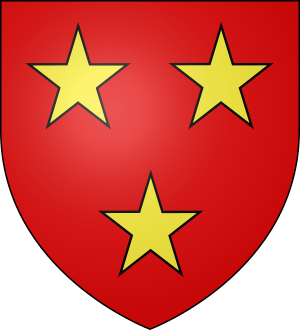John Sutherland, 8th Earl of Sutherland facts for kids
Quick facts for kids
John Sutherland, 8th Earl of Sutherland
|
|
|---|---|

Earl of Sutherland Coat of Arms
|
|
| Born | Unknown |
| Died | 1508 Dunrobin Castle, Sutherland, Scotland |
| Allegiance | Scotland |
| Relations | John Sutherland, 7th Earl of Sutherland (father) Fingole or Catherine, Countess of Sutherland (wife) John Sutherland, 9th Earl of Sutherland (son) Elizabeth Sutherland, 10th Countess of Sutherland (daughter) |
John Sutherland (died 1508) was an important Scottish noble. He was the 8th Earl of Sutherland and the leader, or chief, of the Clan Sutherland. This clan was a powerful family from the Scottish Highlands.
Contents
Becoming Earl of Sutherland
John Sutherland was the son of John Sutherland, 7th Earl of Sutherland. His older brother, Alexander, passed away before their father did. This meant that John became the next Earl of Sutherland. He took on this important role sometime between 1444 and 1456.
Life as Earl
John Sutherland, the 8th Earl, was in charge of the earldom for over 40 years.
Land and Legal Matters
In 1464, King James III of Scotland reviewed royal lands. The Earl of Sutherland was represented during this process. In 1467, John received a special document called a charter. This charter officially gave him control of lands like "Spanziedale" (now Spinningdale) and Pulrossie. These lands had been given to another person, Celestine MacDonald, a few years earlier.
In 1471, the Earl gave a "precept" (a legal order) to John Sutherland of Forse. This order confirmed John of Forse as the heir to his father's lands, including Backies, Torrish, and Drummoy. In the same year, the Earl also granted a charter for lands like Torboll and Pronsy to Nicolas Sutherland.
Disputes and Challenges
In 1476, the Earl of Sutherland had a disagreement with Sir Robert Crichton over land called "Cragton." Important judges, called the Lords Auditors, heard the case and decided against the Earl.
Later, in 1494, the Earl was involved in two more legal cases. One was about land in Strath Ullie and another about land in Caithness. The Lords of Council (a group of royal advisors and judges) asked the Earl to show his legal documents, but no final decision was recorded.
Also in 1494, the Lords of Council stated that the Earl and his helpers were wrong for taking Skelbo Castle. They also said he was wrong for taking two children of John Murray. The Earl was ordered to return the castle to Thomas Kinnaird. He also had to free the children and pay money to Kinnaird. The Murrays and Kinnairds continued to argue over who owned the castle.
Battles and Family Reputation
The Earl is mentioned in connection with the Battle of Aldy Charrish in the 1480s. Some historians say his uncle, Robert Sutherland, led some Sutherland men to help the Clan Mackay fight against the Clan Ross. However, other historians disagree. They say it's unlikely the Earl would have helped against the Rosses because he was married to a daughter of the Ross chief.
Some historians believe that the 7th and 8th Earls of Sutherland did not do much to improve their family's standing. They often left their relatives, like the Murrays, to fight their battles.
Guardianship
In 1494, King James IV of Scotland issued a special legal order concerning the Earl. This order suggested that the Earl might not be able to manage his own affairs. Important officials were appointed to look into this. Although the exact details are not fully known, it seems the Earl was declared unable to manage his business. He was then placed under the care of a "tutor," or guardian. He lived for several more years under this guardianship. In 1499, the Lords of Council ordered that the Earl and his young son be brought to the king.
John Sutherland, the 8th Earl of Sutherland, passed away in 1508.
Family Life
It can be a bit tricky to figure out all the details of John, 8th Earl of Sutherland's marriages. Some historians suggest he first married a daughter of John of Islay, Earl of Ross and Lord of the Isles. Others think he might have married a daughter of Celestine MacDonald.
Records from 1499 mention a divorce between the Earl and his wife, who was named "Fingole." It's not clear who Fingole was, but some think she might have been related to Celestine MacDonald. Later records from 1509 to 1512 mention a "Catherine, Countess of Sutherland," who was receiving money from the earldom. This shows she was the Earl's widow, but it's not known if she was the same person as Fingole.
John Sutherland, 8th Earl of Sutherland, had the following children:
- John Sutherland, 9th Earl of Sutherland: He was the oldest son and became the next Earl. He died in 1514.
- Elizabeth Sutherland, 10th Countess of Sutherland: She became the Countess after her older brother John passed away. She married Adam Gordon, who was a son of George Gordon, 2nd Earl of Huntly, the chief of the Clan Gordon.
- Alexander Sutherland, 1st of Killipheder: He was an illegitimate son. He married a sister of John Mackay, 11th of Strathnaver, the chief of Clan Mackay. Alexander challenged his sister Elizabeth's right to the earldom, possibly encouraged by Mackay. He was later killed by the Gordons.
- George Sutherland: He was another illegitimate son and died when he was young.

